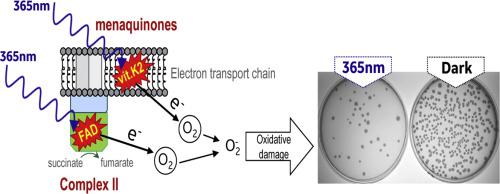Journal of Photochemistry and Photobiology B: Biology ( IF 3.9 ) Pub Date : 2020-05-22 , DOI: 10.1016/j.jphotobiol.2020.111899 Erik Kvam 1 , Kevin Benner 2

|
UV-A and visible light are thought to excite endogenous photosensitizers in microbes, thereby initiating complex chemical interactions that ultimately kill cells. Natural solar-based disinfection methods have been adapted into commercial lighting technologies with varying degrees of reported efficacy and associated safety hazards for human exposure. Here we utilize a narrow-spectrum UV-A LED prototype (currently in development for health care applications) to investigate the mechanism of bacterial photoinactivation using 365 nm light. Using a combination of reverse genetics and biochemical investigation, we report mechanistic evidence that 365nm light initiates a chain-reaction of superoxide-mediated damage via auto-excitation of vitamin-based electron carriers, specifically vitamin K2 menaquinones and the FAD flavoprotein in Complex II in the electron transport chain. We observe that photoinactivation is modifiable through supplementation of the environment to bypass cell damage. Lastly, we observe that bacteria forced into metabolic dormancy by desiccation become hypersensitized to the effects of UV-A light, thereby permitting photoinactivation at fluences that are significantly lower than the industry threshold for safe human exposure. In total, these results substantiate the mechanism and potential application of narrow- spectrum UV-A light for bacterial disinfection purposes.
中文翻译:

通过内源性光敏剂深入了解UV-A介导的细菌消毒的机理。
UV-A和可见光被认为可以激发微生物中的内源性光敏剂,从而引发复杂的化学相互作用,最终杀死细胞。基于自然太阳能的消毒方法已被应用于商业照明技术中,其报道的功效和对人体暴露的相关安全危害程度不同。在这里,我们利用窄光谱UV-A LED原型(当前正在开发用于医疗保健应用)来研究使用365 nm光进行细菌光灭活的机制。通过结合反向遗传学和生化研究,我们报告了机械学证据,即365nm的光通过自动激发基于维生素的电子载体,引发了超氧化物介导的损伤的链反应,特别是电子传输链中复合物II中的维生素K2甲萘醌和FAD黄素蛋白。我们观察到光失活可以通过补充环境来绕过细胞损伤而改变。最后,我们观察到由于干燥而被迫进入代谢休眠状态的细菌对UV-A光的影响变得超敏,从而使通量的光灭活作用大大低于安全的人类暴露阈值。总体而言,这些结果证实了窄光谱UV-A光用于细菌消毒的机理和潜在应用。我们观察到,由于干燥而被迫进入代谢休眠状态的细菌对UV-A光的影响变得超敏,从而使通量的光灭活显着低于安全暴露于人类的行业阈值。总体而言,这些结果证实了窄光谱UV-A光用于细菌消毒的机理和潜在应用。我们观察到,由于干燥而被迫进入代谢休眠状态的细菌对UV-A光的影响变得超敏,从而使通量的光灭活显着低于安全暴露于人类的行业阈值。总体而言,这些结果证实了窄光谱UV-A光用于细菌消毒的机理和潜在应用。











































 京公网安备 11010802027423号
京公网安备 11010802027423号